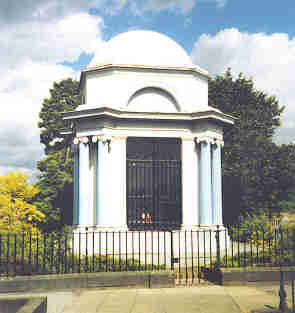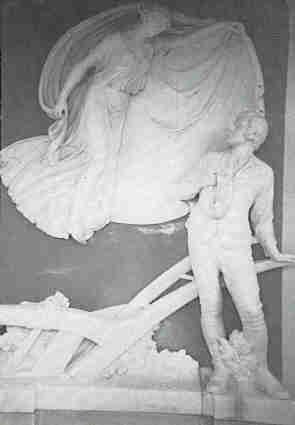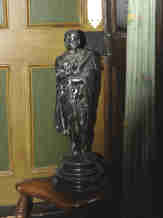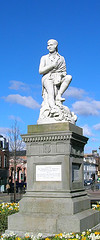|
Dumfries Mausoleum and Statue

The first attempt to have a memorial erected to Burns was made as far back as 1812, by John Forbes Mitchell of Bombay, and it is ironic that the first expression of a national, as opposed to a local, nature, should have come from overseas. Although Mitchell eventually collected a large sum of money for this purpose, it was not until he returned to Britain in 1819 that he could take practical steps to implement his proposals. In the meantime, plans for monuments to Burns had been maturing elsewhere.
Late in 1813 William Grierson and John Syme, close friends of the late poet, took the first steps towards doing something to perpetuate the memory of Burns in a practical form.
A fund for the erection of a mausoleum in St Michael's churchyard was launched on 24th November 1814 and designs were solicited from architects. More than fifty designs from
every part of Britain were submitted, an indication of the widespread interest in Burns at that time. The design submitted by Thomas Frederick Hunt of London was finally chosen, but Hunt very generously waived the fee due to him, regarding it as a great honour to be chosen for so prestigious a project. The building was entrusted to a local contractor, John Milligan and the work was completed by September 1815.
As befitted the sepulchre of Burns and those of his children deceased, some form of sculpture was thought desirable. The honour of producing the first image of Burns in stone was given to Peter Turnerelli (1774-1839), an Irishman of Italian descent working in London. Turnerelli produced a marble group alluding to Burns's dedication of his first volume, The Poetic Genius of my country found me, as the prophetic bard Elijah did Elisha, at the plough and threw her inspiring mantle over me.
Since the phraseology of the dedication was rather high-flown, it was inevitable that in translating this sentiment into marble Turnerelli produced an allegorical composition which has endured a measure of criticism over the years but it must be remembered that Turnerelli was working at a time when classicism was at the height of fashion, and in the context of the early nineteenth century it was no worse than other marble groups of the period. It was well received at the time; the criticisms on aesthetic and factual grounds came much later.
Turnerelli took two years to complete the statuary, but its conveyance, by sea, to Dumfries was delayed till 1819 while the sculptor haggled with the Mausoleum committee over his fee. In this respect he had gone back on his word; while not as public spirited as the architect, Turnerelli promised to let the committee have the sculpture whether their fund reached its target or not. Later, however, he held out for the full amount, impelling the committee to mount a last ditch campaign in the national press to secure the necessary sum.
Turnerelli's statuary endured for over a century, but by the 1920s it was in a poor state. Not only was the marble showing signs of decay but the Mausoleum itself was scandalously neglected. A fund for the restoration was launched in 1928 but it failed to reach its target. Initially it was considered that the statuary should be remodelled in bronze, as likely to last much longer, but the cost of doing this was prohibitive. Even the cost of restoring the statuary was estimated in excess of £3,000. The task of restoring the sculpture was given to Hermon Cawthra who completed the job in 1936, taking the opportunity to rectify the glaring inaccuracies perpetrated by Turnerelli, notably in the footwear and leggings of the ploughman-poet.
Turnerelli's original was transferred to Burns House and' was for some years displayed on the upper floor alongside the famous punch-bowl. Subsequently it was withdrawn from the House and ended up in a builder's yard. It was at one time offered to the Theatre Royal but no space was available. When Burns's first home was refurbished a few years ago consideration was given to housing the statue there but by that time it was too late. The builder had died and his yard had been sold, and the statue has long since disappeared.
This memorial is situated in St Michael's Kirkyard and is modelled on an impressive Grecian Mausoleum. Burns, his widow Jean and five of the family lie here. Burns was originally buried in a modest grave in a corner just to the left of the Mausoleum and it was not until 1815, 20 years after his death that his remains were moved to this more fitting location.
There is a fine plaster mural on the back wall of Burns at the plough with Coila, his Ayrshire muse, overseeing him.

Flaxman (1755-1826) was the foremost British sculptor of his day and he worked on a life-size marble statue of the poet which is in the Scottish National Portrait Gallery in Edinburgh. The Globe Inn, Dumfries has a fine Bronze reduction of this statue.

David O. Hill, had a prodigious output of landscape paintings and pioneer photographic work. His wife Amelia, the sister of the celebrated Edinburgh painter, Sir Noel Paton, was a sculptress of no mean repute who exhibited bust-portraits, animal figures and genre statuettes at the Royal Academy from 1870 onwards.
Elements of all three specialisations are to be found in her best-known work, the statue of Burns which stands in Church Place at the top of the High Street in Dumfries. Although Dumfries could take pride in being the first town to erect a memorial to the poet, there was a feeling that the Mausoleum, tucked away in a quiet corner of St Michael's churchyard on the edge of town was hardly sufficient. A committee was formed by members of the Tam O' Shanter and Queen of the South Burns Clubs, now both defunct, and the necessary funds raised.
Mrs Hill was commissioned to produce a suitable statue and she modelled the seated figure of the poet, with a collie at his feet, in clay. The clay model was then shipped to Italy to be cut in Carrara marble on an enlarged scale. In the process much of the fine detail was lost.
Edward Pinnington, in the Art Journal, wrote: 'The statue suggests sprightly activity and vivacity, something of bubbling vitality and buoyant energy, rather than thought. It is, however, the nearest existing approach to a woman's sculptured thought of Burns, and it is interesting, even if it never was a lofty embodiment of the poet.'
One may detect some male condescension in this criticism. Philip Sulley, Secretary of the Dumfries Centenary Celebration of 1896, may have been no art critic, but he surely echoed the feelings of his townsmen when he wrote: '... the expression is stolid, vacant, meaningless, certainly not the inspired, commanding look of Burns. The base is crowded with inartistic, paltry details - a bonnet, shepherd's pipe of an Italian type, mice, daisies and thistle, while the alleged collie defies description.'
Beauty is thus in the eye of the beholder because It is my thought that this Statue is very imposing. The fact that is is cut in white marble makes this stand out.

|
| |
